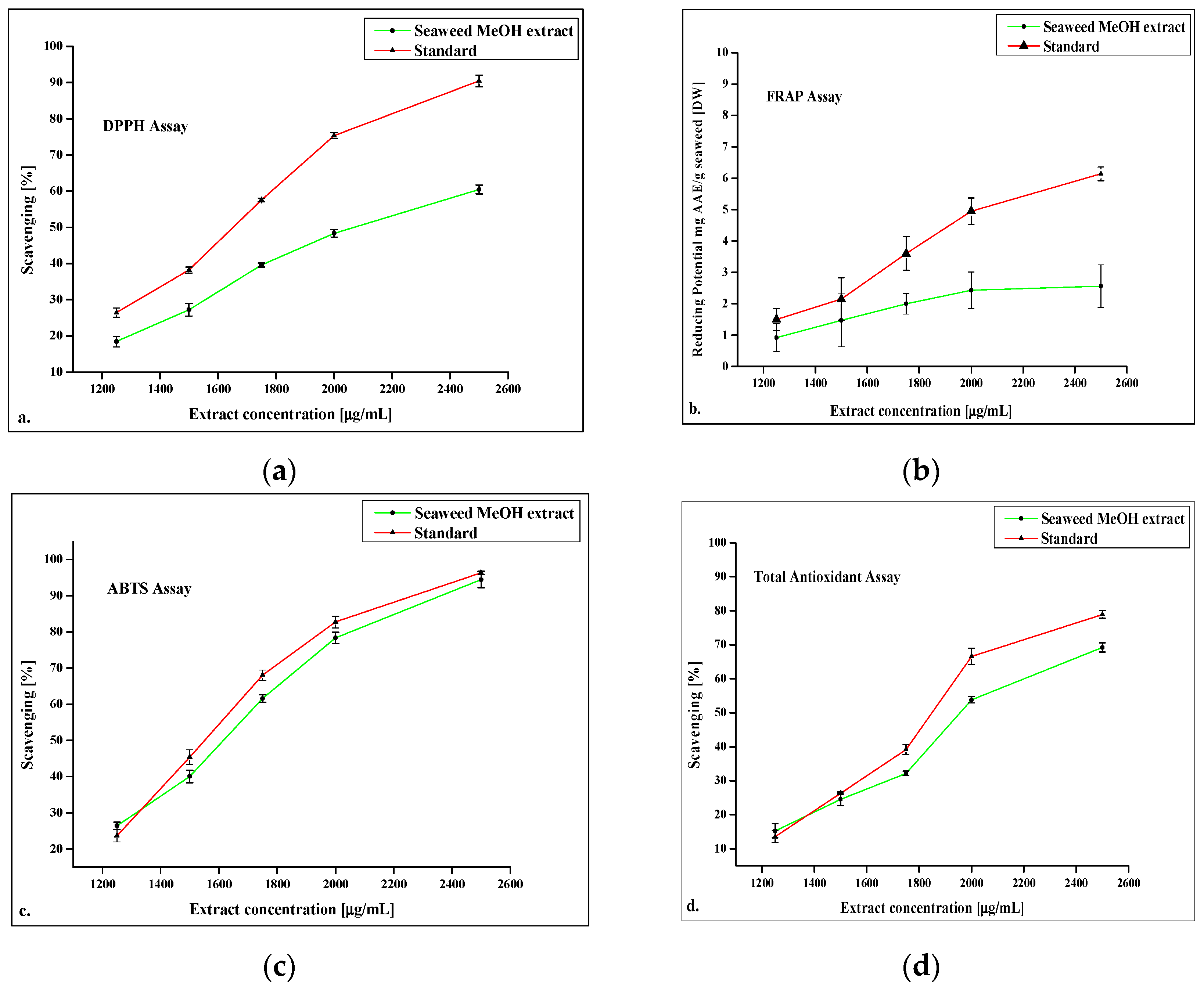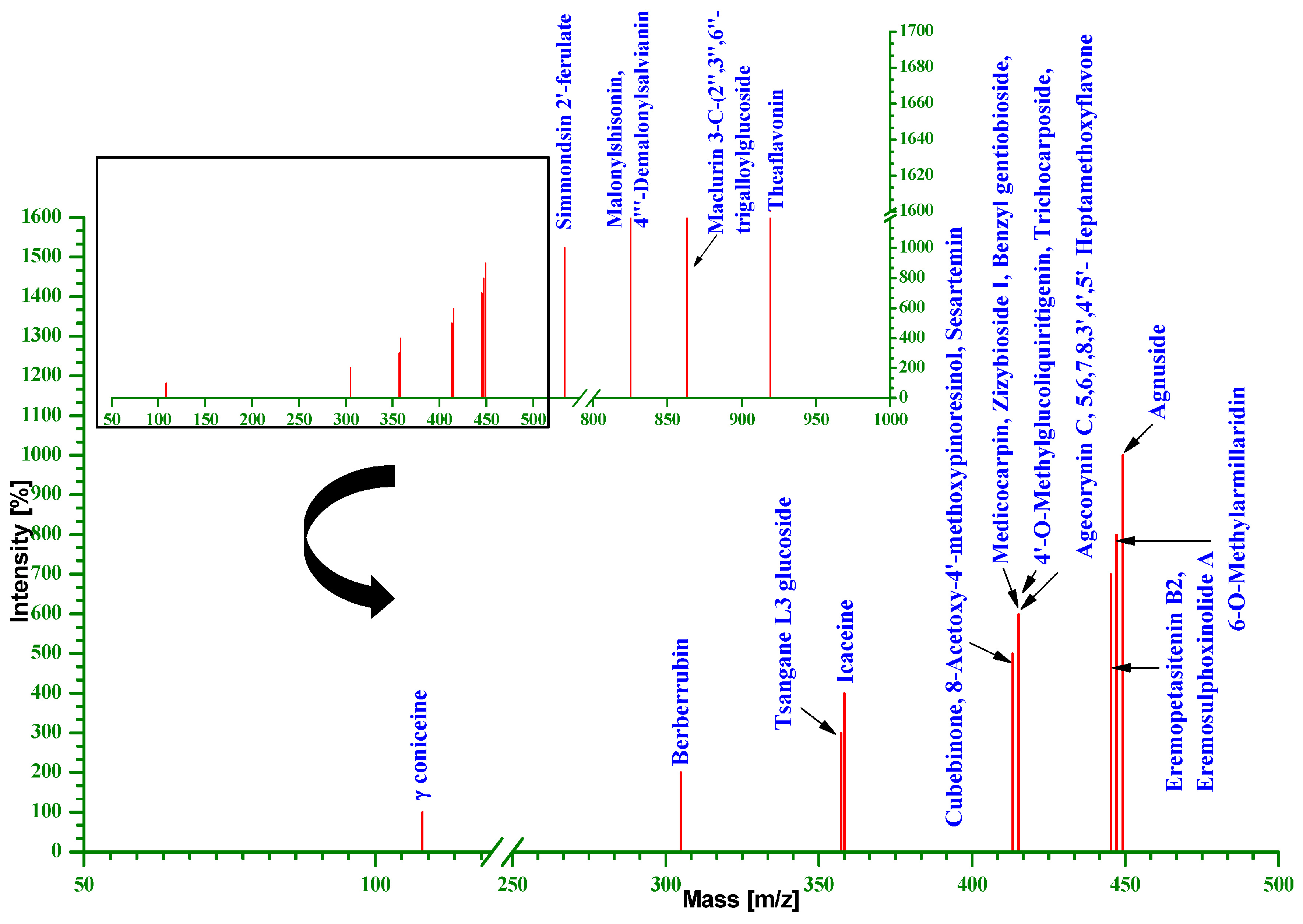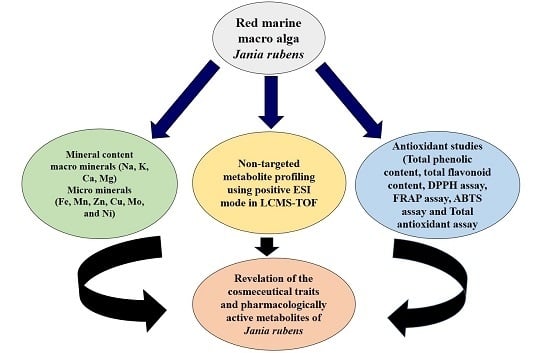Non-Targeted Secondary Metabolite Profile Study for Deciphering the Cosmeceutical Potential of Red Marine Macro Alga Jania rubens—An LCMS-Based Approach
Abstract
:1. Introduction
2. Materials and Methods
2.1. Sample Collection
2.2. Mineral Content Analysis
2.3. Extraction and Identification of Metabolites
2.4. Estimation of Non-Enzymatic Antioxidant Potential
2.4.1. Total Phenolic Content
2.4.2. Total Flavonoid Content (TFC)
2.5. DPPH Radical Scavenging Assay
2.6. Ferric Ion Reducing Antioxidant Power (FRAP) Assay
2.7. ABTS Scavenging Activity
2.8. Total Antioxidant Assay
3. Results
3.1. Proximate Composition
3.2. Total Phenol Content
3.3. Total Flavonoid Content
3.4. DPPH Radical Scavenging Assay
3.5. Ferric Ion Reducing Antioxidant Power (FRAP) Assay
3.6. ABTS Scavenging Activity
3.7. Total Antioxidant Assay
3.8. Metabolite Profiling
4. Discussion
5. Conclusions
Supplementary Materials
Acknowledgments
Author Contributions
Conflicts of Interest
References
- Thomas, N.V.; Kim, S.K. Beneficial Effects of Marine Algal Compounds in Cosmeceuticals. Mar. Drugs 2013, 11, 146–164. [Google Scholar] [CrossRef] [PubMed]
- Kim, S.K.; Ravichandran, Y.D.; Khan, S.B.; Kim, Y.T. Prospectives of the cosmeceuticals derived from marine organisms. Biotechnol. Bioprocess Eng. 2008, 13, 511–523. [Google Scholar] [CrossRef]
- Wijesinghe, W.A.J.P.; Jeon, Y.J. Biological activities and potential cosmeceutical applications of bioactive components from brown seaweeds: A review. Phytochem. Rev. 2011, 10, 431–443. [Google Scholar] [CrossRef]
- Cabrita, M.; Vale, C.; Rauter, A. Halogenated compounds from marine algae. Mar. Drugs 2010, 8, 2301–2317. [Google Scholar] [CrossRef] [PubMed]
- Manach, C.; Scalbert, A.; Morand, C.; Rémésy, C.; Jiménez, L. Polyphenols: Food sources and bioavailability. Am. J. Clin. Nutr. 2004, 79, 727–747. [Google Scholar] [PubMed]
- Zern, T.L.; Fernandez, M.L. Cardio protective effects of dietary polyphenols. J. Nutr. 2005, 135, 2291–2294. [Google Scholar] [PubMed]
- Dunn, W.B.; Ellis, D.I. Metabolomics: Current analytical platforms and technologies. Trends Anal. Chem. 2005, 24, 285–294. [Google Scholar]
- Naidoo, K.; Machin, M.A.B. Oxidative Stress and Ageing: The Influence of Environmental Pollution, Sunlight and Diet on Skin. Cosmetics 2017, 4, 4. [Google Scholar] [CrossRef]
- Joe, M.J.; Kim, S.N.; Choi, H.Y.; Shin, W.S.; Park, G.M.; Kang, D.W.; Kim, Y.K. The inhibitory effects of eckol and dieckol from Ecklonia stolonifera on the expression of matrix metalloproteinase-1 in human dermal fibroblasts. Biol. Pharm. Bull. 2006, 29, 1735–1739. [Google Scholar] [CrossRef] [PubMed]
- Kim, M.M.; Van Ta, Q.; Mendis, E.; Rajapakse, N.; Jung, W.K.; Byun, H.G.; Jeon, Y.J.; Kim, S.K. Phlorotannins in Ecklonia cava extract inhibit matrix metalloproteinase activity. Life Sci. 2006, 79, 1436–1443. [Google Scholar] [CrossRef] [PubMed]
- Price, R.D.; Berry, M.G.; Navsaria, H.A. Hyaluronic acid: The scientific and clinical evidence. J. Plast. Reconstr. Aesthet. Surg. 2007, 60, 1110–1119. [Google Scholar] [CrossRef] [PubMed]
- Ryu, B.; Qian, Z.J.; Kim, M.M.; Nam, K.W.; Kim, S.K. Anti-photoaging activity and inhibition of matrix metalloproteinase (MMP) by marine red alga, Corallina pilulifera methanol extract. Radiat. Phys. Chem. 2009, 78, 98–105. [Google Scholar]
- Verdy, C.; Branka, J.E.; Mekideche, N. Quantitative assessment of lactate and progerin production in normal human cutaneous cells during normal ageing: Effect of an Alaria esculenta extract. Int. J. Cosmet. Sci. 2011, 33, 462–466. [Google Scholar] [CrossRef] [PubMed]
- Rossano, R.; Ungaro, N.; D’Ambrosio, A.; Liuzzi, G.M.; Riccio, P. Extracting and purifying R-phycoerythrin from Mediterranean red algae Corallina elongata. J. Biotechnol. 2003, 101, 289–293. [Google Scholar] [CrossRef]
- Joly, A.B. Generos de Algas Marinhas da Costa Atlantica Latino-Americana; Editora da Universidade de São Paulo: São Paulo, Brazil, 1967; p. 461. [Google Scholar]
- Bôas, V.; Bigio, A.; Figueiredo, M.A.D.O. Are anti-fouling effects in coralline algae species specific? Braz. J. Oceanogr. 2004, 52, 11–18. [Google Scholar] [CrossRef]
- Karabay-Yavasoglu, N.U.; Sukatar, A.; Ozdemir, G.; Horzum, Z. Antimicrobial activity of volatile components and various extracts of the red alga Jania rubens. Phytother. Res. 2007, 21, 153–156. [Google Scholar] [CrossRef] [PubMed]
- Ktari, L.; Blond, A.; Guyot, M. 16β-Hydroxy-5α-cholestane-3, 6-dione, a novel cytotoxic oxysterol from the red alga Jania rubens. Bioorg. Med. Chem. Lett. 2000, 10, 2563–2565. [Google Scholar] [CrossRef]
- El-Din, S.M.M.; El-Ahwany, A.M. El-Ahwany Bioactivity and phytochemical constituents of marine red seaweeds (Jania rubens, Corallina mediterranea and Pterocladia capillacea). J. Taibah Univ. Sci. 2016, 10, 471–484. [Google Scholar] [CrossRef]
- Awad, N.E. Bioactive brominated diterpenes from the marine red alga Jania rubens (L.) Lamx. Phytother Res. 2004, 18, 275–279. [Google Scholar] [CrossRef] [PubMed]
- Navarro, D.A.; Stortz, C.A. The system of xylogalactans from the red seaweed Jania rubens (Corallinales, Rhodophyta). Carbohydr. Res. 2008, 43, 2613–2622. [Google Scholar] [CrossRef] [PubMed]
- Santoso, J.; Gunji, S.; Yoshie-Stark, Y.; Suzuki, T. Mineral contents of Indonesian seaweeds and mineral solubility affected by basic cooking. Food Sci. Technol. Res. 2006, 12, 59–66. [Google Scholar] [CrossRef]
- De Vos, R.C.; Moco, S.; Lommen, A.; Keurentjes, J.J.; Bino, R.J.; Hall, R.D. Untargeted large-scale plant metabolomics using liquid chromatography coupled to mass spectrometry. Nat. Protoc. 2007, 2, 778–791. [Google Scholar] [CrossRef] [PubMed]
- Zhu, Z.J.; Schultz, A.W.; Wang, J.; Johnson, C.H.; Yannone, S.M.; Patti, G.J.; Siuzdak, G. Liquid chromatography quadrupole time-of-flight mass spectrometry characterization of metabolites guided by the METLIN database. Nat. Protoc. 2013, 8, 451–460. [Google Scholar] [CrossRef] [PubMed]
- Kumar, M.; Gupta, V.; Kumari, P.; Reddy, C.R.K.; Jha, B. Assessment of nutrient composition and antioxidant potential of Caulerpaceae seaweeds. J. Food Compos. Anal. 2011, 24, 270–278. [Google Scholar] [CrossRef]
- Lim, S.N.; Cheung, P.C.K.; Ooi, V.E.C.; Ang, P.O. Evaluation of antioxidative activity of extracts from brown seaweed, Sargassum siliquastrum. J. Agric. Food Chem. 2002, 50, 3862–3866. [Google Scholar] [CrossRef] [PubMed]
- Jia, Z.; Tang, M.; Wu, J. The determination of flavonoid contents in mulberry and their scavenging effects on superoxide radicals. Food Chem. 1999, 64, 555–559. [Google Scholar]
- Prieto, P.; Pineda, M.; Anguilar, M. Spectrophotometric quantitation of antioxidant capacity through the formation of a Phosphomolybdenum Complex: Specific application to the determination of Vitamin E. Anal. Biochem. 1999, 269, 337–341. [Google Scholar] [CrossRef] [PubMed]
- Patra, J.K.; Lee, S.-W.; Park, J.G.; Baek, K.-H. Antioxidant and Antibacterial Properties of Essential Oil Extracted from an Edible Seaweed Undaria Pinnatifida. J. Food Biochem. 2017, 41, e12278. [Google Scholar] [CrossRef]
- Duan, X.J.; Zhang, W.W.; Li, X.M.; Wang, B.G. Evaluation of antioxidant property of extract and fractions obtained from a red alga, Polysiphonia urceolata. Food Chem. 2006, 95, 37–43. [Google Scholar] [CrossRef]
- Usman, M.R.M.; Salgar, S.D.; Nagpal, N.; Shaikh, M.Z. Poisonous Herbal Plants: NA; Educreation Publishing: New Delhi, India, 2016. [Google Scholar]
- Fernandes, C.C.; de Carvalho Cursino, L.M.; de Abreu Pinheiro Novaes, J.; Demetrio, C.A.; Júnior, O.L.P.; Nunez, C.V.; do Amaral, I.L. Salicilatos isolados de folhas e talos de Salix martiana Leyb. (Salicaceae). Quim. Nova 2009, 32, 983–986. [Google Scholar] [CrossRef]
- Polya, G. Biochemical Targets of Plant Bioactive Compounds: A Pharmacological Reference Guide to Sites of Action and Biological Effects; CRC Press: Boca Raton, FL, USA, 2003; ISBN 0-415-30829-1. [Google Scholar]
- Ramakrishna, R.; Bhateria, M.; Singh, R.; Puttrevu, S.K.; Bhatta, R.S. Plasma pharmacokinetics, bioavailability and tissue distribution of agnuside following peroral and intravenous administration in mice using liquid chromatography tandem mass spectrometry. J. Pharm. Biomed. Anal. 2016, 125, 154–164. [Google Scholar] [CrossRef] [PubMed]
- Brown, V.; Ducker, S.C.; Rowan, K.S. The effect of orthophosphate concentration on the growth of articulated coralline algae (Rhodophyta). Phycologia 1977, 16, 125–131. [Google Scholar] [CrossRef]
- Boelsma, E.; Hendriks, H.F.J.; Roza, L. Nutritional skin care: Health effects of micronutrients and fatty acids1–3. Am. J. Clin. Nutr. 2001, 73, 853–864. [Google Scholar] [PubMed]
- Denda, M.; Fuziwara, S.; Inoue, K. Influx of Calcium and Chloride Ions into Epidermal Keratinocytes Regulates Exocytosis of Epidermal Lamellar Bodies and Skin Permeability Barrier Homeostasis. J. Investig. Dermatol. 2003, 121, 362–367. [Google Scholar] [CrossRef] [PubMed]
- Wright, J.A.; Richards, T.; Srai, S.K.S. The role of iron in the skin and cutaneous wound healing. Front. Pharmacol. 2014, 5, 156. [Google Scholar] [CrossRef] [PubMed]
- Solomons, N.W.; Ruz, M.; Duran, C.C. Putative therapeutic roles for zinc. In Zinc in Human Biology; Mills, C., Ed.; Springer: London, UK, 1989; pp. 297–321. [Google Scholar]
- Shahidi, F.; Ambigaipalan, P. Phenolics and polyphenolics in foods, beverages and spices: Antioxidant activity and health effects—A review. J. Funct. Foods 2015, 18, 820–897. [Google Scholar] [CrossRef]
- Salavkar, S.M.; Tamanekar, R.A.; Athawale, R.B. Antioxidants in skin ageing—Future of dermatology. Int. J. Green Pharm. 2011, 5, 161–168. [Google Scholar]
- Schreckinger, M.E.; Lotton, J.; Lila, M.A.; De Mejia, E.G. Berries from South America: A comprehensive review on chemistry, health potential, and commercialization. J. Med. Food 2010, 13, 233–246. [Google Scholar] [CrossRef] [PubMed]
- Afaq, F.; Zaid, M.A.; Khan, N.; Dreher, M.; Mukhtar, H. Protective effect of pomegranate-derived products on UVB-mediated damage in human reconstituted skin. Exp. Dermatol. 2009, 18, 553–561. [Google Scholar] [CrossRef] [PubMed]
- Afaq, F.; Khan, N.; Syed, D.N.; Mukhtar, H. Oral feeding of pomegranate fruit extract inhibits early biomarkers of UVB radiation-induced carcinogenesis in Skh-1 hairless mouse epidermis. Photochem. Photobiol. 2010, 86, 1318–1326. [Google Scholar] [CrossRef] [PubMed]
- Seeram, N.P.; Cichewicz, R.H.; Chandra, A.; Nair, M.G. Cyclooxygenase inhibitory and antioxidant compounds from crabapple fruits. J. Agric. Food Chem. 2003, 51, 1948–1951. [Google Scholar] [CrossRef] [PubMed]
- Khan, A.S. Flowering Plants: Structure and Industrial Products; Wiley: Hoboken, NJ, USA, 2017. [Google Scholar]
- Huiling, L.; Xiufang, Y.; Shikang, Z.; Rong, T.; Yunfei, T.; Junhao, K.; Xiaoqiang, C.; Yuping, G. Application of Theaflavin and Skin Care proDuct Containing Theaflavin. Patent No. CN103,083,199 A, 2013. [Google Scholar]
- Michalun, M.V.; Dinardo, J.C. Milady Skin Care and Cosmetic Ingredients Dictionary, 4th ed.; Cengage Learning: Independence, KY, USA, 2014. [Google Scholar]
- Ahn, S.J.; Cho, E.J.; Kim, H.J.; Park, S.N.; Lim, Y.K.; Kook, J.K. The antimicrobial effects of deglycyrrhizinated licorice root extract on Streptococcus mutans UA159 in both planktonic and biofilm cultures. Anaerobe 2012, 18, 590–596. [Google Scholar] [CrossRef] [PubMed]
- Adianti, M.; Aoki, C.; Komoto, M.; Deng, L.; Shoji, I.; Wahyuni, T.S. Anti-hepatitis C virus compounds obtained from Glycyrrhiza uralensis and other Glycyrrhiza species. Microbiol. Immunol. 2014, 58, 180–187. [Google Scholar] [CrossRef] [PubMed]
- Khan, R.; Khan, A.Q.; Lateef, A.; Rehman, M.U.; Tahir, M.; Ali, F. Glycyrrhizic acid suppresses the development of precancerous lesions via regulating the hyper proliferation, inflammation, angiogenesis and apoptosis in the colon of Wistar rats. PLoS ONE 2013, 8, e56020. [Google Scholar]
- Chandrasekaran, C.V.; Deepak, H.B.; Thiyagarajan, P.; Kathiresan, S.; Sangli, G.K.; Deepak, M. Dual inhibitory effect of Glycyrrhiza glabra (GutGardTM) on COX and LOX products. Phytomedicine 2011, 18, 278–284. [Google Scholar] [CrossRef] [PubMed]
- Fatemeh, V.; Mohsen, F.M.; Kazem, B. Evaluation of inhibitory effect and apoptosis induction of Zyzyphus jujube on tumor cell lines, an in vitro preliminary study. Cytotechnology 2008, 56, 105–111. [Google Scholar]
- Krings, U.; Berger, R.G. Antioxidative activity of some roasted foods. Food Chem. 2001, 72, 223–229. [Google Scholar] [CrossRef]
- Qi, H.M.; Zhang, Q.B.; Zhao, T.T.; Chen, R.; Zhang, H.; Niu, X.Z.; Li, Z. Antioxidative activity of different sulfate content derivatives of polysaccharide extracted from Ulva pertusa (Chlorophyta) in vitro. Int. J. Biol. Macromol. 2005, 37, 195–199. [Google Scholar] [CrossRef] [PubMed]
- Wang, S.; Zhang, J.; Zhang, Z.; Gao, W.; Yan, Y.; Li, X.; Liu, C. Identification of Chemical Constituents in the Extract and Rat Serum from Ziziphus Jujuba Mill by HPLC-PDA-ESI-MSn. Iran. J. Pharm. Res. 2014, 13, 1055–1063. [Google Scholar] [PubMed]
- Sok, D.E.; Oh, S.H.; Kim, Y.B.; Kang, H.G.; Kim, M.R. Neuroprotection by extract of Petasites japonicus leaves, a traditional vegetable, against oxidative stress in brain of mice challenged with kainic acid. Eur. J. Nutr. 2006, 45, 61–69. [Google Scholar] [CrossRef] [PubMed]
- Choi, O.B. Anti-allergic effects of Petasites japonicas. Korean J. Food Nutr. 2002, 5, 382–385. [Google Scholar]
- Abbassy, M.A.; Abdelgaleil, S.A.M.; Belal, A.S.H.; Rasoul, M.A.A.A. Insecticidal, antifeedant and antifungal activities of two glucosides isolated from the seeds of Simmondsia chinensis. Ind. Crop. Prod. 2007, 26, 345–350. [Google Scholar] [CrossRef]
- Arya, D.; Khan, S. A Review of Simmondsia chinensis (Jojoba) “The Desert Gold”: A Multipurpose Oil Seed Crop for Industrial Uses. J. Pharm. Sci. Res. 2016, 8, 381–389. [Google Scholar]
- Malty, R.H.; Naim, A.A.; Khalifa, A.E.; Azizi, M.M.A. Anti-inflammatory effects of jojoba liquid wax in experimental models. Pharmacol. Res. 2005, 51, 95–105. [Google Scholar]
- Yao, J.L.; Fang, S.M.; Liu, R.; Oppong, M.B.; Liu, E.W.; Fan, G.W.; Zhang, H. A Review on the Terpenes from Genus Vitex. Molecules 2016, 21, 1179. [Google Scholar] [CrossRef] [PubMed]
- Atta-ur-Rahman. Studies in Natural Products Chemistry, Bioactive Natural Products (Part L); Elsevier Science: Amsterdam, The Netherlands, 2005; Volume 32, p. 1268. [Google Scholar]
- Pandey, A.; Bani, S.; Satti, N.K.; Gupta, B.D.; Suri, K.A. Anti-arthritic activity of agnuside mediated through the down-regulation of inflammatory mediators and cytokines. Inflamm. Res. 2012, 61, 293–304. [Google Scholar] [CrossRef] [PubMed]
- Tiwari, N.; Luqman, S.; Masood, N.; Gupta, M.M. Validated high performance thin layer chromatographic method for simultaneousquantification of major iridoids in Vitex trifolia and their antioxidant studies. J. Pharm. Biomed. Anal. 2012, 61, 207–214. [Google Scholar] [CrossRef] [PubMed]
- Okuyama, E.; Fujimori, S.; Yamazaki, M.; Deyama, T. Pharmacologically active components of viticis fructus (Vitex rotundifolia). II. The components having analgesic effects. Chem. Pharm. Bull. 1998, 46, 655–662. [Google Scholar] [CrossRef] [PubMed]
- Nelly, A.; Annick, D.D.; Frederic, D. Plants used as remedies antirheumatic and antineuralgic in the traditional medicine of Lebanon. J. Ethnopharmacol. 2008, 120, 315–334. [Google Scholar]
- Jeon, Y.W.; Jung, J.W.; Kang, M.R.; Chung, I.K.; Lee, W.T. NMR Studies on Antitumor Drug Candidates, Berberine and Berberrubine. Bull. Korean Chem. Soc. 2002, 23, 391–394. [Google Scholar]
- Goyal, A.; Sharma, V.; Upadhyay, N.; Gill, S.; Sihag, M. Flax and flaxseed oil: An ancient medicine & modern functional food. J. Food Sci. Technol. 2014, 51, 1633–1653. [Google Scholar] [PubMed]
- Mao, J.; Yu, N.-J.; Yang, Y.; Zhao, Y.-M. Biological activities of dibenzyl butyrolactone lignans, Research advances. J. Int. Pharm. Res. 2014, 41, 275–281. [Google Scholar]
- Chandra, H.; Bishnoi, P.; Yadav, A.; Patni, B.; Mishra, A.P.; Nautiyal, A.R. Antimicrobial Resistance and the Alternative Resources with Special Emphasis on Plant-Based Antimicrobials—A Review. Plants 2017, 6, 16. [Google Scholar] [CrossRef] [PubMed]
- Windayani, N.; Rukayadi, Y.; Hakim, E.H.; Ruslan, K.; Syah, Y.M. Antifungal activity of lignans isolated from Phyllanthus myrtifoliu Moon against Fusarium oxysporum. Curr. Top. Phytochem. 2014, 12, 33–39. [Google Scholar]
- Elfahmi, N.V. Phytochemical and Biosynthetic Studies of Lignans, with a Focus on Indonesian Medicinal Plants. Ph.D. Thesis, University Library Groningen, Groningen, The Netherlands, 2006. [Google Scholar]
- Lin, X.; Zhou, L.; Li, T.; Brennan, C.; Fu, X.; Liu, R.H. Phenolic content, antioxidant and antiproliferative activities of six varieties of white sesame seeds (Sesamum indicum L.). RSC Adv. 2017, 7, 5751–5758. [Google Scholar] [CrossRef]
- Renault, B.; Catroux, P. Cosmetic Use of Lignans. Patent No. EP1,526,832 A1, 4 May 2005. [Google Scholar]
- Toshihiko, O.; Keiko, N.; Kyoko, S.; Takemoto, Y.; Kabushiki, K. Protein Composition Derived from Sesame Seed and Use Thereof. U.S. Patent 5,993,795 A, 30 November 1999. [Google Scholar]
- Midland, S.L.; Izac, R.R.; Wing, R.M.; Zaki, A.I.; Munnecke, D.E.; Sims, J.J. Melleolide, a new antibiotic from Armillaria mellea. Tetrahedron Lett. 1982, 23, 2515–2518. [Google Scholar] [CrossRef]
- Donnelly, D.M.; Abe, F.; Coveney, D.; Fukuda, N.; O’Reilly, J.; Polonsky, J.; Prangé, T. Antibacterial sesquiterpene aryl esters from Armillaria mellea. J. Nat. Prod. 1985, 48, 10–16. [Google Scholar] [CrossRef] [PubMed]
- Bedoux, G.; Hardouin, K.; Burlot, A.S.; Bourgougnon, N. Bioactive Components from Seaweeds: Cosmetic Applications and Future Development. Adv. Bot. Res. 2014, 71, 345–378. [Google Scholar]
- Rozkin, M.; Levina, M.N.; Efimov, V.S.; Usov, A.I. The anticoagulant and lipolysis-stimulating activity of polysaccharides from marine brown algae. Farmakol. Toksikol. 1991, 54, 40–42. [Google Scholar] [PubMed]
- Gedouin, A.; Vallee, R.; Morvan, P.Y. Use of Algae Extract to Stimulate the Oxygen Uptake by the Cells Having Lipolytic Effect to Produce ATP Molecules. Patent No. FR 2,879,098 A1, 16 June 2006. [Google Scholar]
- Chan, Y.Y.; Kim, K.H.; Cheah, S.H. Inhibitory effects of Sargassum polycystum on tyrosinase activity and melanin formation in B16F10 murine melanoma cells. J. Ethnopharmacol. 2011, 137, 1183–1188. [Google Scholar] [CrossRef] [PubMed]
- Spolaore, P.; Joannis-Cassan, C.; Duran, E.; Isambert, A. Commercial Applications of Microalgae. J. Biosci. Bioeng. 2006, 101, 201–211. [Google Scholar] [CrossRef] [PubMed] [Green Version]



| Mineral Composition | |
|---|---|
| Macro Minerals (mg (100 g)−1 DW) | |
| Na | 1215 ± 1.00 |
| K | 627.33 ± 1.52 |
| Ca | 14,790.33 ± 1.46 |
| Mg | 2228.08 ± 2.09 |
| Na + K + Ca + Mg | 18,860.74 ± 1.60 |
| Micro Minerals (mg (100 g)−1 DW) | |
| Fe | 84.93 ± 0.89 |
| Cu | 0.63 ± 0.05 |
| Zn | 1.35 ± 0.12 |
| Mn | 1.23 ± 0.15 |
| Ni | Nd |
| Fe + Cu + Zn + Mn + Ni | 88.15 ± 0.89 |
| Total (Macro + Micro minerals) | 18,948.89 ± 1.06 (mg (100 g)−1 DW) |
© 2017 by the authors. Licensee MDPI, Basel, Switzerland. This article is an open access article distributed under the terms and conditions of the Creative Commons Attribution (CC BY) license (http://creativecommons.org/licenses/by/4.0/).
Share and Cite
Dixit, D.; Reddy, C.R.K. Non-Targeted Secondary Metabolite Profile Study for Deciphering the Cosmeceutical Potential of Red Marine Macro Alga Jania rubens—An LCMS-Based Approach. Cosmetics 2017, 4, 45. https://doi.org/10.3390/cosmetics4040045
Dixit D, Reddy CRK. Non-Targeted Secondary Metabolite Profile Study for Deciphering the Cosmeceutical Potential of Red Marine Macro Alga Jania rubens—An LCMS-Based Approach. Cosmetics. 2017; 4(4):45. https://doi.org/10.3390/cosmetics4040045
Chicago/Turabian StyleDixit, Dhara, and C. R. K. Reddy. 2017. "Non-Targeted Secondary Metabolite Profile Study for Deciphering the Cosmeceutical Potential of Red Marine Macro Alga Jania rubens—An LCMS-Based Approach" Cosmetics 4, no. 4: 45. https://doi.org/10.3390/cosmetics4040045






